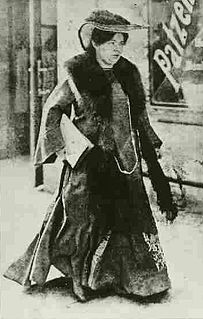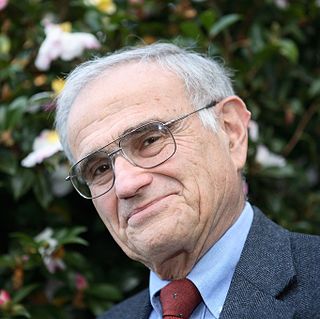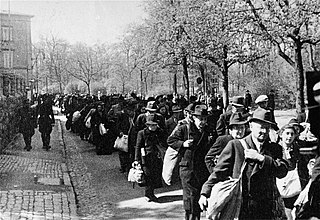Related Research Articles

The Final Solution or the Final Solution to the Jewish Question was a Nazi plan for the genocide of Jews during World War II. The "Final Solution to the Jewish question" was the official code name for the murder of all Jews within reach, which was not restricted to the European continent. This policy of deliberate and systematic genocide starting across German-occupied Europe was formulated in procedural and geopolitical terms by Nazi leadership in January 1942 at the Wannsee Conference held near Berlin, and culminated in the Holocaust, which saw the murder of 90% of Polish Jews, and two-thirds of the Jewish population of Europe.

The Reich Security Main Office was an organization subordinate to Heinrich Himmler in his dual capacity as Chef der Deutschen Polizei and Reichsführer-SS, the head of the Nazi Party's Schutzstaffel (SS). The organization's stated duty was to fight all "enemies of the Reich" inside and outside the borders of Nazi Germany.
Abortion in Germany is without punishment in the first trimester under the condition of mandatory counseling and is permitted later in pregnancy in cases that the pregnancy poses an important danger to the physical or mental health of the pregnant woman. In the case that the abortion is not because of rape, the woman needs to receive counseling, called Schwangerschaftskonfliktberatung, at least three days prior to the abortion and must take place at a state-approved centre, which afterwards gives the applicant a Beratungsschein. Abortions that do not meet these conditions are illegal.

The Madagascar Plan was a proposal by the Nazi German government to forcibly relocate the Jewish population of Europe to the island of Madagascar. Franz Rademacher, head of the Jewish Department of the German Foreign Office, proposed the idea in June 1940, shortly before the Fall of France. The proposal called for the handing over of control of Madagascar, then a French colony, to Germany as part of the eventual peace terms.

Helene Stöcker was a German feminist, pacifist and gender activist. She successfully campaigned keep same sex relationships between women legal, but she was unsuccessful in her campaign to legalise abortion. She was a pacifist in Germany. As war emerged she fled to Norway and as that was invaded she moved to Japan and emigrated to America in 1942.

The history of the Jews during World War II is almost synonymous with the persecution and murder of Jews which was committed on an unprecedented scale in Europe and European North Africa. The massive scale of the Holocaust which happened during World War II greatly affected the Jewish people and world public opinion, which only understood the dimensions of the Final Solution after the war. The genocide, known as HaShoah in Hebrew, aimed at the elimination of the Jewish people on the European continent. It was a broadly organized operation led by Nazi Germany, in which approximately six million Jews were murdered methodically and with horrifying cruelty. Although the Holocaust was organized by the highest levels of the Nazi German government, the vast majority of Jews murdered were not German, but were instead residents of countries invaded by the Nazis after 1938. Of the approximately 6 million Jews murdered by the Nazis, approximately 160,000 to 180,000 were German Jews. During the Holocaust in occupied Poland, more than one million Jews were murdered in gas chambers of the Auschwitz concentration camp alone. The murder of the Jews of Europe affected Jewish communities in Albania, Austria, Belarus, Belgium, Bosnia & Herzegovina, Channel Islands, Croatia, Czech Republic, Estonia, France, Germany, Greece, Hungary, Italy, Latvia, Libya, Lithuania, Luxembourg, Moldova, the Netherlands, North Macedonia, Norway, Poland, Romania, Russia, Serbia, Slovakia, and Ukraine.
Within nations occupied by the Axis powers in World War II, some citizens and organizations, prompted by nationalism, ethnic hatred, anti-communism, antisemitism, opportunism, self-defense, or often a combination, knowingly collaborated with the Axis Powers. Some of these collaborators committed war crimes, crimes against humanity, or atrocities in the Holocaust.

The Holocaust in Poland was part of the European-wide Holocaust organized by Nazi Germany and took place in German-occupied Poland. During the genocide, three million Polish Jews were murdered, half of all Jews murdered during the Holocaust.
Jewish Bolshevism, also Judeo–Bolshevism, is an anti-communist and antisemitic canard, which alleges that the Jews were the originators of the Russian Revolution in 1917, and that they held primary power among the Bolsheviks who led the revolution. Similarly, the conspiracy theory of Jewish Communism alleges that Jews have dominated the Communist movements in the world, and is related to the Zionist Occupation Government conspiracy theory (ZOG), which alleges that Jews control world politics.

The Holocaust, also known as the Shoah, was the genocide of European Jews during World War II. Between 1941 and 1945, Nazi Germany and its collaborators systematically murdered some six million Jews across German-occupied Europe, around two-thirds of Europe's Jewish population. The murders were carried out in pogroms and mass shootings; by a policy of extermination through labor in concentration camps; and in gas chambers and gas vans in German extermination camps, chiefly Auschwitz-Birkenau, Bełżec, Chełmno, Majdanek, Sobibór, and Treblinka in occupied Poland.

Responsibility for the Holocaust is the subject of an ongoing historical debate that has spanned several decades. The debate about the origins of the Holocaust is known as functionalism versus intentionalism. Intentionalists such as Lucy Dawidowicz argue that Adolf Hitler planned the extermination of the Jewish people as early as 1918, and personally oversaw its execution. However, functionalists such as Raul Hilberg argue that the extermination plans evolved in stages, as a result of initiatives that were taken by bureaucrats in response to other policy failures. To a large degree, the debate has been settled by acknowledgement of both centralized planning and decentralized attitudes and choices.

The Haavara Agreement was an agreement between Nazi Germany and Zionist German Jews signed on 25 August 1933. The agreement was finalized after three months of talks by the Zionist Federation of Germany, the Anglo-Palestine Bank and the economic authorities of Nazi Germany. It was a major factor in making possible the migration of approximately 60,000 German Jews to Palestine in 1933–1939.

The Wehrmacht was the unified armed forces of Nazi Germany from 1935 to 1945. It consisted of the Heer (army), the Kriegsmarine (navy) and the Luftwaffe. The designation "Wehrmacht" replaced the previously-used term Reichswehr, and was the manifestation of the Nazi regime's efforts to rearm Germany to a greater extent than the Treaty of Versailles permitted.
The Holocaust in the Soviet Union is the Nazi German persecution of Jews, Roma and homosexuals as part of the Holocaust in World War II. It may also refer to the Holocaust in the Baltic states, annexed by the Soviet Union before the start of Operation Barbarossa.

The German occupation of Belgium during World War II began on 28 May 1940, when the Belgian army surrendered to German forces, and lasted until Belgium's liberation by the Western Allies between September 1944 and February 1945. It was the second time in less than thirty years that Germany had occupied Belgium.

The occupation of Poland by Nazi Germany and the Soviet Union during World War II (1939–1945) began with the German-Soviet invasion of Poland in September 1939, and it was formally concluded with the defeat of Germany by the Allies in May 1945. Throughout the entire course of the occupation, the territory of Poland was divided between Nazi Germany and the Soviet Union (USSR) both of which intended to eradicate Poland's culture and subjugate its people. In the summer-autumn of 1941, the lands which were annexed by the Soviets were overrun by Germany in the course of the initially successful German attack on the USSR. After a few years of fighting, the Red Army drove the German forces out of the USSR and crossed into Poland from the rest of Central and Eastern Europe.

In German military history, Bandenbekämpfung, also Nazi security warfare, refers to the concept and military doctrine of countering resistance or insurrection in the rear area during wartime through extreme brutality. The doctrine provided a rationale for disregarding the established laws of war and for targeting of any number of groups, from armed guerrillas to the civilian population, as "bandits" or "members of gangs". As applied by the German Empire and later by Nazi Germany, it became instrumental in the mass crimes against humanity committed by the two regimes, including the Herero and Namaqua genocide and the Holocaust.

Michael Albert Meyer is a German-born American historian of modern Jewish history. He taught for over 50 years at the Hebrew Union College-Jewish Institute of Religion in Cincinnati, Ohio. He is currently the Adolph S. Ochs Emeritus Professor of Jewish History at that institution. He was one of the founders of the Association for Jewish Studies, and served as its president from 1978–80. He also served as International President of the Leo Baeck Institute from 1992–2013. He has published many books and articles, most notably on the history of German Jews, the origins and history of the Reform movement in Judaism, and Jewish people and faith confronting modernity. He is a three-time National Jewish Book Award winner.

The question of how much Germans and other Europeans knew about the Holocaust while it was ongoing continues to be debated by historians. With regards to Nazi Germany, some historians argue that it was an open secret amongst the population whilst others highlight a possibility that the German population were genuinely unaware of the Final Solution. Peter Longerich argues that the Holocaust was an "open secret" by early 1943, but some authors place it even earlier. However, after the war, many Germans claimed that they were ignorant of the crimes perpetrated by the Nazi regime, often using the stereotypical phrase "davon haben wir nichts gewusst".

The Mölln arson attack was the first fatal case of far-right extremists setting fire to migrants' homes in Germany. On the night of 22 November 1992, 2 German men with neo-Nazi ties set fire to the 2 houses of Turkish families in Mölln, in Schleswig-Holstein, Germany. 3 Turks died in the attack while 9 others were injured.
References
- ↑ "Prof. Atina Grossmann Named as Davis Fellow". The Cooper Union. Retrieved 5 January 2016.
- ↑ "Fellow Dr. Atina Grossmann". United States Holocaust Memorial Museum. Retrieved 5 January 2016.
- ↑ "Atina Grossmann". The Cooper Union. Retrieved 5 January 2016.